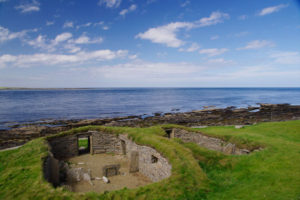Investigating the evolution of house societies in Orkney
For decades, the accepted view of the Orcadian Neolithic was one of two cultural packages with a sharp break in the middle. New research has revealed a much more complex and nuanced picture, however. Carly Hilts spoke to Colin Richards to find out more.

The traditional understanding of the Neolithic period in Orkney has long been of a game of two halves, with each half represented by completely different cultural packages. The ‘early’ phase, in the 4th millennium BC, was associated with simple, single farmsteads and ‘stalled’ burial cairns (so-called because their interiors are divided into compartments using upright stones projecting from the side walls). They also contain Unstan ware pottery, a shallow, round-bottomed form with decoration limited to a collar below the rim. Sweeping in at the turn of the 3rd millennium BC, the late Neolithic apparently brought with it villages, passage-grave tombs, and flat-bottomed, ornately decorated Grooved ware pottery. With no clear sign of a transition between these two phenomena, it was suggested that this break might represent the arrival of a new group replacing the earlier culture. Recent analysis, however, is presenting a more nuanced picture. New dating evidence confirms an idea originally suggested by Colin Renfrew, blurring the lines between ‘early’ and ‘late’ Neolithic categories.

It was to explore the idea of ‘two Neolithics’ further, and to learn more about 3rd millennium BC activity beyond known monuments and settlement complexes such as Barnhouse (CA 131) and the Ness of Brodgar (CA 246) that the Cuween-Wideford Landscape Project was set up in 1994. The University of Glasgow-funded initiative initially focused on Stonehall Farm, Mainland – where promising magnetic signals were found to represent the well-preserved remains of a mid to late 4th millennium BC dispersed settlement that had graduated to a late Neolithic village in the late 3rd millennium BC – but the Project was soon uncovering traces of similarly early activity at other sites. The programme of excavation, fieldwalking, and geophysical survey quickly expanded to investigate the whole of the Bay of Firth – an area of Mainland surrounded by hills, about 7km east of the Stenness-Brodgar ritual complex. Now published in a mighty new monograph, the team’s findings would prove revolutionary.
A tomb of one’s own
A major milestone came while investigating several Neolithic stone structures at Wideford Hill in 2002. On what was intended to be the last day of fieldwork, the team realised that these buildings did not represent the earliest phase of occupation on the site: there were traces of older timber structures beneath. This pattern was repeated across Orkney, emerging at Green, Eday, Ha’Breck, Wyre, and within the Bay of Firth at Smerquoy (CA 291) in 2013, while the stone houses at the Knap of Howar, an early Neolithic settlement on Papa Westray, also appear to represent secondary activity; although no tell-tale postholes have yet been spotted here, the dwellings stand amid the remains of earlier midden material. This was a completely unexpected development, as wooden structures were not previously thought to have been part of the Orcadian Neolithic. Yet here was undisputable evidence of extensive earlier activity.

These discoveries would also shake another long-held belief about Neolithic Orkney: that stalled cairns and stone houses came together as a package to mark the start of the period. At early Neolithic sites like the Knap of Howar, Stonehall Meadow, Smerquoy, and the Knowes of Trotty, they even use the same architecture, dividing their internal space using pairs of orthostats. It had been suggested that these tombs were mimicking domestic architecture, creating ‘houses for the dead’. Yet new dating evidence has turned this picture completely on its head.
Radiocarbon dating places the earliest stalled cairns in c.3600-3500 BC – but samples taken during the project reveal that stone houses do not start to appear until around 300 years later. Instead, the tomb-builders seem to have lived in the timber houses identified nearby. It appears that burial cairns were not modelled on dwellings, but the other way around. So why were people choosing to build and live in houses designed to look like tombs?

It could be that their driving impulse was to demonstrate genealogical links, the team suggests. Settlements born out of small kinship groups were expanding and beginning to incorporate ‘outsiders’, looking back to their ancestors and fusing past and present generations in the fabric of their homes – ‘a desire to materially highlight ancestry and descent,’ as Professor Colin Richards of Manchester University, co-editor of the monograph, describes it.
If Orkney’s earliest settlements emphasised blood relationships, however, the shift to stone might reflect a change of direction. Building in wood gives any structure a finite lifespan, and those excavated during the project show frequently shifting footprints, and little sign of decayed posts being replaced. Building in stone, however, roots a structure in one location. Indeed, continuity seems to have been accorded much greater importance during this period, as at several sites the team noted building materials being recycled again and again as the settlements expand.
It is also worth noting that the excavated stone structures are generally significantly larger than the timber buildings that they replaced, meaning that they could have accommodated many more people. Given that building in stone would have been much more labour-intensive (both in terms of procuring raw materials and in raising the house itself) than with wood, it seems likely that we are seeing the results of cooperation between larger groups. Might this hint at the advent of a more collectivist style of living, of bigger social units being brought together – and into being?
All images: Colin Richards
This is an extract from a feature published in CA 318. Click here to subscribe.



